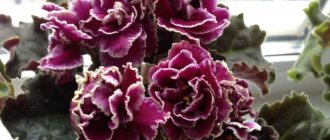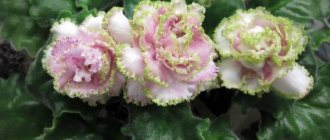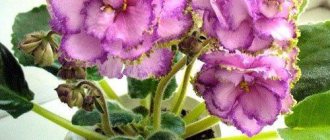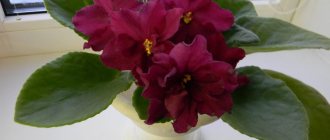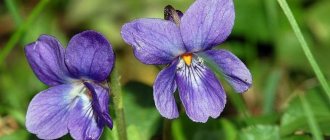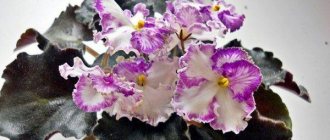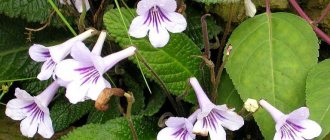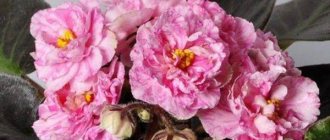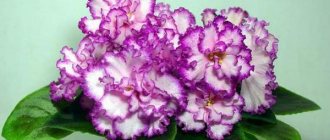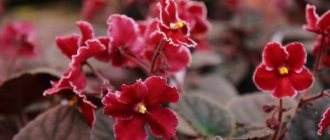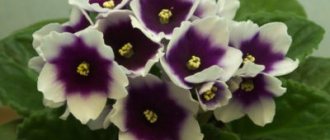It is impossible to imagine any collection of a true lover and connoisseur of flowers without violets. In the modern floristry industry, there are an innumerable number of these flowers, the number of their varieties is constantly growing thanks to the tireless and continuous work of breeders.
We invite you to get acquainted with the magnificent works of the collector and great lover of violets Tatyana Lvovna Dadoyan.
Briefly about the breeder
Tatyana Lvovna Dadoyan is a Russian violet breeder. Tatyana herself can’t stand it when the word “breeder” is applied to her. The activities of this woman remained secret for a long time. She was engaged in breeding new varieties of violets exclusively for herself; this activity was a simple hobby for her.
She presented about 10 varieties of her violets to the society. These plants seem truly perfect. They are endowed with incredible colors and shades, they are characterized by a chic shape of buds and flowers. And their abundant and long-lasting flowering can captivate a true connoisseur.
Display of life phases
The seedling is characterized by the occurrence of all the main life processes in rhythmic accordance with the flow of similar phases of most varieties of the genus Saintpaulia.
At the same time, the process of creating a comfortable microclimate for a tropical beauty is greatly simplified for flower growers, since care regimes can be built and calculated according to a general model, taking into account individual nuances.
Specifics of room development
The seedling, along with its spectacular decorative appearance, is distinguished by:
- Problem-free character;
- And it does not require flower growers to create complicated conditions for its growth.
This makes the violet ideal for the collections of those new to the cultivation and distribution of Saintpaulias.
Among the positive properties of the seedling are :
- The ability to independently assemble an excellent decorative outlet;
- Rapid growth and harmonious development of a compact outlet;
- Gorgeous flowering in large volumes with frequently repeating waves of buds;
- Significant diameter of flowers with original texture;
- Rare formation of color variations and resistance to changes in regimes;
- Willing propagation using leaf cuttings, in most cases maintaining the color scheme.
Like all violets, the seedling has specific developmental features :
- Explicit temperature dependence, which affects the decorativeness of the seedling;
- The color intensity of flowers gradually increases, reaching a maximum by the third flowering;
- Preferred location on window sills – love for natural light;
- Wavy configuration of leaves, giving volume to the rosette;
- The simultaneous presence of corollas of double and simple structure during flowering.
Formation of an adult specimen
The process of passing through the maturation phase of a seedling approximately corresponds to the general rules and timing for the Saintpaulia genus, depending on the method chosen for obtaining young specimens.
If, to begin the formation of a violet, you take a baby from a leaf cutting, then the first flowering can occur eight months from the moment the embryo of the future baby is laid - the appearance of flowers coincides with the end of the teenage phase and the entry of the violet into adulthood.
Peculiarity of reproduction
To obtain young specimens of seedlings, it is enough to use one of the possible vegetative propagation methods, but it is preferable to form violets from children planted on specially selected and prepared leaf cuttings. The seedling is capable of producing such children in large quantities.
The seedling can just as easily be propagated by stepsons, carefully separated from the adult violet and rooted in water or directly in a pot with substrate.
But in the case of rejuvenation of an adult violet, all the qualities of the seedling are always fully preserved .
Effect of heat on seedling flowers
The seedling, like almost all Saintpaulias of K. Morev, depends on changes in temperature . Flowers on a violet that blooms when the thermometer is cool have:
- Quite weak tinting of shades;
- Pale "peas";
- Or the complete predominance of white color.
In a hot microclimate, the seedling fully displays its decorative qualities - its finger coloring is maximally intense, and the radiance of the peas gives the seedling its magnificent appearance.
Violet flowers and buds are extremely feared:
- Temperature changes;
- And drafts.
Therefore, in indoor culture, tropical beauties should be protected from these negative factors.
Pedicel structure
A distinctive feature of a seedling is the formation, from the moment of the first bud formation, of a large number of very strong and shortened peduncles , the strength of which is sufficient to maintain the voluminous bouquets of the seedling in an upright position throughout the long period of their flowering.
Flowering type
By the third flowering, the seedling is capable of forming large volumes of cap-type flowers from large and showy flowers.
Lifespan of a flower
The presented violet blooms for almost two months.
Waves of seedling flowering last almost two months , and each individual flower is able to maintain a fresh decorative appearance for about four weeks.
The most popular varieties and their photos
Dadoyan has been breeding for about 5 years and during this time there are no more than 20 varieties of her selection. But the most commonly heard representatives in the world are the following:
"Water"
The flowers are bright deep blue, double, with dashes or lightened fragments along the edges of the petals of a pinkish tint. Along the edge of the petals there is a green ruffled border. The leaves are dark, quilted with a slightly wavy edge. Sometimes the leaves have red spots on the white backside. The violet grows quickly, the buds blooming very slowly, but simultaneously.
"Grinya"
The flowers are large, fluffy, semi-double and double, white with a thick ruffled green ruffle along the edge of the petals. The leaves are regular, lanceolate, slightly pubescent. It blooms with a magnificent bouquet, abundant flowering.
"Droplet"
This is a plant with large, semi-double, white flowers with wavy edges of the petals. Each flower has a distinct purple eye in the center of the bud. The leaves are elongated, light green in color.
The rosette is neat at the root. The plant blooms quickly, blooms profusely and for a long time.
"Maria"
Curly sport from the Fairy variety. It has large, heavily double pink flowers with a raspberry coating and a green ruffle along the pom-pom flower.
"Snow White"
The flowers are large, in the form of fluffy terry balls of pure white color with wavy edges of the petals. The leaves of the violet are glossy, wavy, bright green. The plant stands out for its abundant bouquet flowering.
"Wild Cherry"
The flowers of the plant are large, semi-double, bright cherry color with a clear, wide white border. Externally, the flower can be compared to a multi-pointed three-dimensional star. The leaves are dark green, spoon-shaped, lanceolate. Wild cherry is a sport from the Frosty Cherry variety.
"Running on the waves"
The flowers are huge, double, variable white with dark blue fragments interspersed. The leaves are regular, dark green. The rosette is neat at the root. The plant blooms quickly, blooms profusely and for a long time.
"Georgia"
The flowers are large, double, bright pink with a crimson border, the edges of the border are decorated with a thick, corrugated green ruffle. Strong peduncles, curly basal rosette.
The leaves are regular, slightly pubescent. Georgia contains a lot of buds on the bush, the flowering period is short.
"Poet Yuri Gal"
This is a soft pink, “porcelain” violet, it got its name in honor of the poet Gal, whose prisoner Tatyana’s father once saved in Stalin’s camps. Then Dadoyan had one goal - to save, survive and joy will come.
Violet Maria (T. Dadoyan)
Tender violet Maria (T. Dadoyan).
The species that loves mountainous Africa, “violet” (or Saintpaulia), contains both annual and perennial plants. It belongs to the Gesneriaceae family. The flower has enjoyed enormous unabating popularity all over the world for many decades. The species is valuable not only for the diverse beauty of its varieties, but also for its rather unpretentious maintenance requirements.
The main thing is to know the basics of care, and sincerely admire your specimen - this way the plant will try its best to please the owner with exuberant flowering.
History of origin
Experienced and widely known breeder Tatyana Lvovna Dadoyan obtained Maria by sporting from the Fairy variety. The fairy, a double miracle, covered with large white flowers with a deep pink tint, became a good parent, passing on to Mary all her varietal beauty. This is how a luxurious fixed sport turned out.
The variety belongs to Tatyana Dadoyan.
Quote (T.L. Dadoyan): “The flowers are large, up to 7 cm. Densely double, they remain in the form of “heads of cabbage” for a long time during dissolution. The petals are white with a slight pinkish tint, along the edge there is a crimson border with a dusting and a thick green ruffle. The leaf is medium green, wavy.”
Maria has the same one as the Fairy:
- Fluffy corrugated edge frill of petals;
- And the delightful shape of the flowers, reminiscent of a delicate rose enclosed in a head of cabbage.
Distinctive features
- Densely double large flowers (5 – 7 cm);
- The petals are white with a pinkish tint, the border is from fuchse to bright crimson, ending in a light green thick ruffle;
- The brightness of the color is determined by temperature and lighting;
- Flowering is exceptionally long;
- The leaves are standard, lush green, with a light wavy edge and curly at the rosette;
- Loose, voluminous rosette;
- The petioles are long.
The plant develops slowly; before flowering it needs to become sufficiently strong, but this feature is more than compensated for by its unpretentiousness and abundance of children.
Advice! A real varietal plant will “overgrow” with a light green ruffle in any case, but to be sure, you should wait for at least the third flowering.
Description of the best varieties
Most often the names of three violets of Tatiana's selection come up. What do these unique flowers look like?
Plant selection 2010. Appearance:
- the flowers are large, double, white with a pink tint in the center, they have a gorgeous pink wavy edge, which is highlighted by fuchsia dots;
- the flower stalks of the plant are dense and strong;
- the socket is smooth and compact;
- leaves are straight, regular in shape, quilted, wavy along the edge, dark green, glossy;
- the stem is short, emerging from a basal leaf rosette;
- each flower has its own pedicel;
- pedicels slightly pubescent.
- when the flower just opens, it is pure white, the pink border appears over time;
- violet loves a lot of light;
- sometimes a sport plant grows - this is a modified flower, the border does not appear, pink stains appear slightly on the double bud;
- the plant grows slowly.
About planting, growing and diseases
This plant is very sensitive to the composition of the soil when planting. She prefers acidic soil compositions. Therefore, the base must be peat.
If you choose the option with clay and heavy soil, the plant will unfortunately die. The soil should be light, airy and permeable. It is recommended to add vermiculite and perlite to the substrate. Which will absorb, retain and release moisture. Such additives should make up no more than 50% of the total mass.
The growing process also has its own characteristics.
It is very important to take care of the right pot. Adviсe:
- The diameter of the container should be 3 times smaller than the outlet itself.
- Use pots with a stand; they will be more stable.
- Make holes in the pot so that excess water can escape.
- For planting, it is best to use plastic containers. A clay pot retains water, which can lead to mold.
Violet is often exposed to various types of diseases; let’s take a closer look at the most common ones:
- Root-knot nematode. A disease that leads to the rapid development of root processes, in which worms eventually appear. There is no point in fighting nematodes. You will have to remove the affected plant. Wash the pot thoroughly.
- Spider mites. To combat it, you need to treat it with an insecticide intended for indoor plants: Omite, Magus, Nissoran, Apollo.
Anyone who is thinking about growing violets at home, we recommend that you familiarize yourself with such varieties as the amazing “Chanson”, the well-known “Pansy”, the lily-of-the-valley “Greenhouse Effect”, the lovely “Cherry”, the lushly blooming “Isadora” and “ Bronze Horseman”, exquisite “Blue Mist”, as well as the famous varieties of violets of the “Optimara” series.
It is the “Fairy” type of violet that attracts lovers with its luxurious and lush blooms, which can be admired for ages. But for all its beauty, this flower requires increased attention, because if it is not cared for properly, it will stop blooming, then begin to wither and, as a result, the plant will die.
Materials from the Types section
Everyone’s favorite varieties of violets from the Optimara series - My desire, My love and others: history of appearance, description and photo
Description and photo of violets by breeder Elena Korshunova: Shanghai rose, Bullfight, Charmel and others
Beautiful and delicate violets by Boris Mikhailovich and Tatyana Makuni: Forest magic, Coquette, Jupiter and Your Majesty
Photos and descriptions of violets by breeder Evgeny Arkhipov - “Egorka well done”, “Aquarius” and others
Description and photo of violets of the “Cherry” variety. Features of “Frosty” and “Winter”, care for them
Distinctive features
Tatyana Dadoyan is working on the discovery of new species of Uzambara violets. The flowers of the breeder Dadoyan have a number of distinctive features:
- In almost all varieties, the shape of the leaves is regular, spoon-shaped, the leaf edges are smooth (less often jagged or wavy);
- leaves are lanceolate, glossy with slight pubescence;
- Dadoyan violets love a lot of light;
- all flowers in all varieties are in the form of terry pompoms;
- the leaves of all varieties of Uzambara violets emerge from one point, all of them are collected in a basal rosette;
- The flowering of violets is abundant and long, the majority of varieties are characterized by slow opening of buds;
- Violets bloom in a bouquet, each flower has its own separate miniature pubescent peduncle.
Possible problems in growing
With improper care and decreased immunity, violets may lose their decorative appearance.
Problems with leaves
The edges of the leaves may begin to yellow and dry out. The probable cause is the appearance of rot due to excessive watering.
- If a mosaic appears on the leaf blades, this means that too much bright light is falling on the bush, or there is a lack of microelements in the soil.
- When the edge of the leaf becomes dark, the crop is probably affected by a fungal disease.
Diseases
Fairy is a violet that is periodically affected by powdery mildew, bacteriosis, rust, root and stem rot. Pathogenic microorganisms enter the bushes when planted in contaminated soil and are transferred from other plants. Rot occurs when the substrate is over-watered.
Violet affected by disease
To prevent diseases of violets, preventive measures must be taken. First of all, after purchasing, quarantine the flowers, do not use soil from other plants, water moderately, and protect from drafts.
Note! When transplanting a diseased plant, the pot is thoroughly disinfected.
Pests
The Fairy violet can be attacked by sucking and gnawing pests. Aphids, thrips, and scale insects extract juice from the leaves. The above-ground and underground parts are eaten by weevils, mites, and nematodes. To get rid of insects, bushes are sprayed with disinfectants 2-3 times with a break of 10 days.
A sign that the plant has been overcome by scale insects is the presence of white fluff at the base. To rid a violet of pests, it needs to be washed with water, sprayed with a chemical, and replanted in new soil.
In case of nematode damage, the same actions are performed, but the damaged roots are first removed.
Signs of improper care
If not properly maintained, the following happens:
- When the light is too bright, the leaves droop.
- If the pot is too large, the violet does not bloom, but grows young rosettes.
- If there is an excess of nitrogen in the soil, flowering does not occur.
Drooping violet leaves
- In hot weather and long daylight hours, the leaf blades curl inward.
- If violets do not have enough light, the leaves become small.
- If the root system rots, the flower is over-flooded with water.
The Fairy Violet is a spectacular houseplant. This culture is capricious, but if its requirements are met correctly, it will delight you with flowering for 8-9 months a year.
About the breeder
Tatyana Lvovna Dadoyan is a Russian breeder . Tatyana herself cannot stand it when the word “breeder” is applied to her. The activities of this woman remained secret for a long time.
She was engaged in breeding new varieties of violets exclusively for herself; this activity was a hobby for her. Dadoyan released her plants to people in 2012, when she heard that all combination options in the selection of Uzambara violets had already been sorted out and there could be no new discoveries.
The most popular varieties
Dadoyan worked with violets for about 5 years and during this time there are no more than 20 varieties of her selection. The most commonly heard varieties are :
Georgia - violet flowers are large, double, bright pink in color with a crimson border-spray, the edges of the border are decorated with a thick, corrugated green ruffle. Strong peduncles, curly basal rosette. The leaves are regular, slightly pubescent. Georgia contains a lot of buds on the bush, the flowering period is short.- Maria is a beautiful curly sport from the Fairy variety. It has large, heavily double pink flowers with a raspberry coating and a green ruffle along the pom-pom flower.
- Aquatic - flowers are bright deep blue, double, with streaks or lightened fragments along the edges of the petals of a pinkish tint. Along the edge of the petals there is a green ruffled border. The leaves are dark, quilted with a slightly wavy edge. Sometimes the leaves have red spots on the white backside. The violet grows quickly, the buds blooming very slowly, but simultaneously.
- Snow White - the flowers of the plant are large, in the form of fluffy terry balls of pure white color with wavy edges of the petals. The leaves of the violet are glossy, wavy, bright green. The plant stands out for its abundant bouquet flowering.
- Grinya - flowers are large, fluffy, semi-double and double, white with a thick corrugated green ruffle along the edge of the petals. The leaves are regular, lanceolate, slightly pubescent. It blooms with a magnificent bouquet, abundant flowering.
- Droplet is a plant with large, semi-double, white flowers with wavy edges of the petals. Each flower has a distinct purple eye in the center of the bud. The leaves are elongated, light green in color. The rosette is neat at the root. The plant blooms quickly, blooms profusely and for a long time.
- Wild cherry - the flowers of the plant are large, semi-double, bright cherry color with a clear, wide white border. Externally, the flower can be compared to a multi-pointed three-dimensional star. The leaves are dark green, spoon-shaped, lanceolate. Wild cherry is a sport from the Frosty Cherry variety.
- Running on the waves - the flowers are huge, double, variable white with dark blue fragments interspersed. The leaves are regular, dark green. The rosette is neat at the root. The plant blooms quickly, blooms profusely and for a long time.
- The poet Yuri Gal is a soft pink, “porcelain” violet; it got its name in honor of the poet Gal, whose prisoner Tatyana’s father once saved in Stalin’s camps. Then Dadoyan had one goal - to save, survive and joy will come. This plant is capricious; if not properly cared for, it quickly dies, but its goal is also to survive and give joy.
Possible problems in growing
Saintpaulia Fairy requires special attention. At the same time, she reacts poorly to any mistakes in care. As a result, the plant's immunity is reduced.
Problems with leaves
The appearance of yellow spots on leaves can be due to 2 reasons. In the first case, water got on them during irrigation, and in the second, burns appeared under the influence of direct sunlight.
Important! To correct the situation, it is necessary to adjust the conditions of detention
Pests
The fairy may suffer from pests. In this case, the growth and development of the plant will be slowed down. In addition, the violet will not be able to fully bloom until the problem is completely eliminated.
The main Fairy pests:
- Spider mite. The lesion can be recognized by the slow growth of the central part of the rosette. In addition, the leaves become covered with a light yellowish coating, and subsequently with a thin cobweb. To destroy the pest, it is necessary to spray the violet twice with an interval of 7 days with Actellik or Fitoverm.
- Thrips. Small harmful insects that feed on the sap of leaves. As a result of this, the plates are deformed, and their edges turn down. To combat thrips, it is recommended to use Inta-Vir or Iskra.
Diseases
A fairy can also suffer from various diseases. The most common of them are:
- Powdery mildew. It appears as a white coating on the leaves, which subsequently acquires a brown tint. As a result, the process of photosynthesis is disrupted. The leaves eventually wilt completely. For treatment it is recommended to use: “Topaz”, “Skor”.
- Root rot. Develops as a result of stagnation of moisture in combination with low temperature. The disease can be recognized by the loss of turgor in the leaves, which indicates a nutritional disorder. You can save the plant if you root the top of the rosette or leaf cuttings in a timely manner.
Signs of improper care
When growing Fairy violets, it is necessary to comply with the basic requirements of the culture. Otherwise, lush flowering will never occur.
General signs indicating errors in care:
- depressed appearance of the outlet;
- the buds dry out without opening;
- withered leaves;
- the surface of the plates does not shine;
- slow growth or its complete absence;
- deformed sheet plates.
Violet Fairy is an unusual variety that, when grown correctly, amazes with the beauty of its flowers. But to achieve such a result, you must strictly adhere to the rules of care. Otherwise, flowering may never occur or it will be very sparse, and the lover of indoor plants will never understand why this is happening.
Description of the best views and photos
Most often, the names of three violets of Tatyana’s selection come up among flower growers. What are they, these magnificent flowers?
"Fairy Dadoyan"
Plant selection 2010. Appearance :
- the flowers are large, double, white with a pink tint in the center, they have a gorgeous pink wavy edge, which is highlighted by fuchsia dots;
- the flower stalks of the plant are dense and strong;
- the socket is smooth and compact;
- leaves are straight, regular in shape, quilted, wavy along the edge, dark green, glossy;
- the stem is short, emerging from a basal leaf rosette;
- each flower has its own pedicel;
- pedicels slightly pubescent.
Peculiarities:
- When the flower first opens, it is pure white, with a pink border appearing over time.
- Violet loves a lot of light.
- Sometimes a sport plant grows - this is a modified flower, the border does not appear, pink stains appear slightly on the terry bud.
- The plant is not early ripening and grows slowly.
"Raspberries"
Plant selection 2011. Appearance :
- the flowers are large, double, like a pompom, bright crimson, the edges of the petals are wavy;
- leaves are regular, spoon-shaped, dark green, lanceolate, glossy, slightly pubescent;
- stems are short, pubescent, emerging from a basal rosette;
- the socket is compact, but folds out well;
- one stem may have several pedicels (inflorescence umbrella);
- peduncles erect, buds heavy.
Peculiarities:
- During the flowering period, the flowers bloom slowly but amicably.
- The plant requires a sufficient amount of light, but does not tolerate active exposure to the sun.
- The buds can tilt the peduncle, this can lead to creases and death of the flower.
"Marquise"
Plant selection 2011. Appearance :
- the flowers are large, double, bright pink with a crimson edge and a thin white edge and a wave along the edge;
- leaves are dark, glossy with a slight edge;
- the shape of the leaves is regular, spoon-shaped, the leaf edges are smooth;
- pedicels-stalks emerge from the basal rosette;
- the flower stalks of the plant are dense and strong;
- the socket is smooth and compact;
- the pedicels are pubescent.
Peculiarities:
- The awning is demanding in terms of lighting, does not tolerate the aggression of the sun, but also does not like constant shadow; on cloudy days, additional illumination with a photo lamp is required, and in extreme heat, shading of the plant is necessary.
- Young seedlings quickly and actively grow foliage.
- The variety develops quickly and blooms early.
Next you can watch a video review of this variety:
Contents in room culture
The seedling is not a “capricious” variety and responds favorably to careful and regular implementation of simple care regimens that are used for a large number of representatives of the Saintpaulia genus :
- Placement of the seedling is shown on the western or eastern window; windows facing north need additional equipment with artificial light, and when the window faces south, artificial shade is needed for the plant;
- It is better to water in moderate doses, after a slight degree of drying for the upper tier of the substrate;
- about the need to apply additional mineral fertilizers by the condition of the violet;
The variety requires proper care.
The Miracle Pea seedling is liked by many gardeners.
Distinctive features of flowers
Its flowers have a number of distinctive features:
- all flowers in all varieties are in the form of terry pompoms;
- the leaves of all varieties of Uzambara violets emerge from one point, all of them are collected in a basal rosette;
- In almost all varieties, the shape of the leaves is regular, spoon-shaped, the leaf edges are smooth (less often jagged or wavy);
- leaves are lanceolate, glossy with slight pubescence;
- Dadoyan violets love a lot of light;
- The flowering of violets is abundant and long, the majority of varieties are characterized by slow opening of buds;
- Violets bloom in a bouquet, each flower has its own separate miniature pubescent peduncle.
The species and varieties of violets considered by this breeder are true works of floristic art. Terry Dadoyan's terry violets will bring bright colors to any home and dilute your gray everyday life with their beauty.
If you find an error, please select a piece of text and press Ctrl+Enter.
- Author: Maria Sukhorukikh
Rate this article:
- 5
- 4
- 3
- 2
- 1
(0 votes, average: 0 out of 5)
Share with your friends!
Energy influence and superstitions
A description of indoor violets will be incomplete without mentioning their energy component. Violets are very sensitive not only to drafts from the window, but also to bad energy in the house.
In homes where there is a lot of arguing and family members suffer from mood swings and depression, violets usually bloom poorly and tend to disappear.
Attention! The zodiac sign that violet corresponds to is Taurus. Like this sign, Saintpaulias symbolize harmony, stability and tranquility.
Violet brings peace and harmony to the home, cleanses the space of negativity
Bringing wealth into the home, improves health and extends life expectancy
Violet brings peace and harmony to the house, cleanses the space of negativity. By bringing wealth into the home, it improves health and extends life expectancy.
The energy of plants depends partly on their color:
- white - purity, femininity, peace, tranquility, liberation from oppression. This color is suitable for calming, both for people in a state of aggression and for those who are emotionally very sensitive.
Dulling the feeling of anger, worries and fears, communication with a white violet brings peace. It is recommended to place white violets in rooms where children live, especially if quarrels often arise between them;
- red of all shades - cleanse the house of negative energy, treat depression, and help pessimists. A person who has a violet of these colors in his house begins to have a more positive attitude towards his life;
- blue and blue - personify the unification of the earthly and airy, awakens creative abilities. They are often placed in the rooms of children who are trying to teach art - music, singing, drawing. Blue color also reduces appetite, and it is useful to place them in the kitchen if you want to lose weight;
- purple - helps mutual understanding, comprehension of the spiritual, wise, as well as for meditation and reading the future. They are hosted by teachers, writers, psychologists, philosophers and thinkers.
